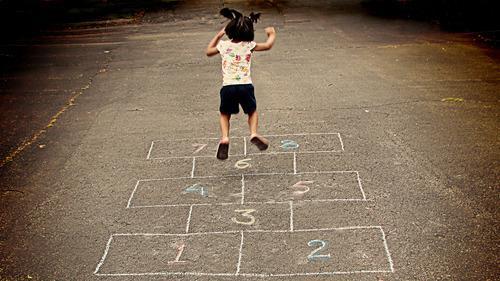
Puzzles, blocks, board games, and pick-up sticks might seem to have gone the way of penny candy and being allowed to walk home from school alone at 8 years old when it comes to today’s kids. But these “old-fashioned” games do something for children that iPads, and the TV never will. They still offer children a better sense of how to manipulate and exist in the world around them. So what are the top five simple games that help build this sense of space?
Battleship: In Battleship, children are thinking about space. They need to figure out which direction their ship is in and how they can use effective questioning to get there.
Hopscotch: This very physical game also involves numbers. Children practice large and small motor skills and spatial relationships as they draw the game with chalk. And then throw their stones and jump along the numbered spaces.
Chutes and Ladders: Many parents probably have fond memories of this game and of rolling the dice and climbing to the top only to shoot back down the slide. But this game is more than just luck and chance and fun. There is a counting, math ability to it all, but also a strong sense of spatial orientation. Where is my opponent compared to me? How can I catch him? What number do I need to get to get there?
Jenga: There was no game more exciting — or more simple — than Jenga. Simply pull a block from the tower and hope and pray it doesn’t fall. But there is so much more to it. Children develop eye-hand coordination and experiment with gravity as well as cause and effect.
Blocks: Give a child an old-fashioned stack of blocks and let them go to town. They are feeling the weight of the blocks in their hands. They are imagining something in their head and making it real. Blocks help children learn how to sense and change the world around them.
本时文内容由奇速英语国际教育研究院原创编写,禁止复制和任何商业用途,版权所有,侵权必究!
1.What do the five games in common?
A They are all related with the electronic games.
B They help develop children’s sense of direction.
C They let the children let numbers before school.
D They lead the children understand their parents.
解析:选B。B。推理判断题。根据第一段第四句的So what are the top five simple games that help build this sense of space?可以得知,这五种游戏都是和培养孩子的方向感有关的。
2.What is the writer’s attitude to the old-fashioned games?
A They are still very beneficial.
B They should be thrown away.
C They are much cheaper to use.
D They make children feel lonely.
解析:选A。A。推理判断题。从文章第一段第二句的They still offer children a better sense of可以推知,作者认为古老的儿童游戏仍然是非常有用的。
3.What should children do at first when playing Hopscotch?
A They should ask a lot of questions.
B They should figure out the direction.
C They should throw their stones.
D They should get the space numbered
解析:选D。D。细节理解题。根据第三段第三句的And then throw their stones and jump along the numbered spaces可以得知,孩子们要扔石头并且沿着已经标好数字的空格跳,因此他们要做的事情是要先标好数字。
4.Which of the following games can help children’s maths?
A Battleship.
B Hopscotch.
C Chutes and Ladders.
D Blocks.
解析:选C。C。细节理解题。根据第四段第三句的There is a counting, math ability to it all, but also a strong sense of spatial orientation可知梯子和滑梯游戏中有需要孩子计算的部分,因此该游戏是和数学能力有关的。
5.Who will be the winner of Jenga?
A The one who keeps the tower stand.
B The one who can change the world.
C The one who feels blocks in hands.
D The one who pulls block from towers.
解析:选A。A。细节理解题。根据第五段第二句的Simply pull a block from the tower and hope and pray it doesn’t fall可知在层层叠游戏中抽出一块板后,然后“祈祷塔不要倒掉”,据此可以推知能够赢得的人肯定是能够让塔屹立不倒的人。